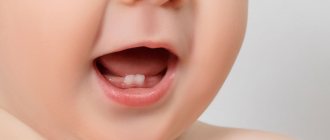How many baby teeth do children have?
Milk teeth and even some molars begin to form at the stage of intrauterine development. Of course, a child has no visible teeth at birth - they begin to erupt only after 6 months. During this six-month period, they are hidden under the gums, but slowly develop and form, beginning to move outward.
In total, a child grows 20 baby teeth:
- Central and lateral incisors – 8.
- Fangs – 4.
- First and second molars – 8.
Their main function is to form a space where molars will then grow.
Recommendations for caring for a child's molars
Children's molars require careful care. Young enamel is sensitive to the external environment and bacteria that cause caries. Therefore, it is important to use hygiene products.
The best prevention is to teach your child to maintain good oral hygiene before a permanent bite has formed. To keep your teeth healthy, you need to follow a few simple steps:
- brush your teeth every day ☑️. Brush at least twice a day, use dental floss and mouthwash.
- correct diet ☑️. Sweet plaque on teeth is the best food for bacteria. After meals with a lot of carbohydrates, brush your teeth or rinse your mouth. Avoid snacking when you can't take care of your teeth.
- regular preventive examinations ☑️. You need to visit the dentist once every six months. Treat teeth immediately when problems are detected.
- strengthen teeth ☑️. Eat a balanced diet, take vitamin and mineral complexes rich in calcium.
- Visit the dentist regularly ☑️ and have your teeth professionally cleaned.
Taking care of your teeth doesn't take much time, but taking simple steps now will help you maintain beautiful, healthy teeth for life.
How many teeth should a child have per year?
During this period, baby teeth begin to cut.
They begin to break out in the following sequence on the upper and lower jaws. On the top:
- 8-12 months. Central incisors.
- 9-13 months. Lateral incisors.
- 16-22 months. Fangs.
- 13-19 months. First molars.
- 25-33 months. Second molars.
In the lower jaw, this process is distributed in time somewhat differently:
- 6-10 months. Central incisors.
- 10-16 months. Lateral incisors.
- 17-23 months. Fangs.
- 14-18 months. First molars.
- 23-31 months. Second molars.
It is worth noting that these time limits are averaged and deviations up or down by 1-3 months are considered normal.
If you want to know how many teeth a child has per year is considered normal, you should refer to the chart described above. You get that at the age of 12 months there should be 6-8 of them.
Features of the period
PHOTO: The lateral incisors of the upper jaw do not have enough space in the dentition and, therefore, they erupted in the anterior direction - crowding of the teeth of the upper jaw formed.
The permanent incisors are wider and higher than the primary incisors, therefore, as they appear, the interdental spaces decrease (in the primary bite, there are normally large gaps between the incisors and canines), and the jaws grow. If in the primary occlusion there were no spaces between the incisors and canines, then the eruption of the permanent incisors will be accompanied by the formation of crowding of teeth in the anterior part of the lower and upper jaws.
As a result of active sports, injury to the front teeth of the upper jaw often occurs. Most often, complete dislocation of the incisors occurs when, as a result of a strong blow, the tooth falls out of its socket.
To prevent dislocation and fracture of permanent incisors, it is enough to wear a special sports individual dental mouth guard (boxing or hockey) made by a children's orthodontist during sports (hockey, karate).
Changing baby teeth to molars
Around the age of 4, a child’s growth spurt begins, the jaws enlarge and the baby teeth seem to move apart, with gaps appearing between them – trema. If this does not happen and by the age of 5 the teeth are still tight, you need to show the child to the dentist, as there may not be enough space for permanent teeth.
At about 5-6 years of age, baby teeth begin to become loose and gradually fall out, which indicates that the molars are already beginning to grow underneath them. Usually this process of change lasts for 5-8 years and the final formation of the dentition occurs somewhere around 14-15 years.
This happens in the following order:
- 5-6 years – lower and upper incisors.
- 7-8 years – lower and upper lateral incisors.
- 8-10 years – upper and lower molars.
- 9-11 years – upper and lower canines.
- 11-13 years – upper and lower molars.
Milk teeth are replaced by permanent molars. Their number at the age of 14-16 years is 28. At the same time, the third molars (wisdom teeth) are already formed, but they begin to grow only after 18 years. True, not all people grow them. It all depends on individual characteristics.
Typical problems.
The most typical problem between the ages of 3 and 6 years is the development of caries of primary teeth in the area of the first and second primary molars. The narrow interdental spaces between the first and second primary molars, which are difficult for a child to reach, are an ideal place for plaque to accumulate. As a result, caries forms on the surface of the teeth hidden from the eyes of parents (between the 4th and 5th milk teeth). Being unnoticed, the carious process quickly progresses, complicated by inflammation of the nerve of the tooth (pulpitis).
With poor oral hygiene and a large number of carious teeth, caries of the permanent molar (6th tooth) often develops, high-quality treatment of which is only possible by a pediatric dentist.
How many teeth should a child have?
It all depends on age. The maximum number of teeth in the period from birth to 5-6 years is 20 - these are milk teeth. Then, until the age of 15-16, the molars begin to erupt, pushing out the milk teeth. Ultimately, their number grows to 28.
The latest are the third molars. They grow only after 18 years of age, but not everyone has them.
It is worth noting that the period of formation and eruption of baby teeth is very individual. In some children, all 20 teeth grow by the age of 2, while in others - by 2.5 or later. Such delays within a year are considered normal and are not a developmental anomaly.
If teeth do not start cutting in the first year of the baby’s life, you should consult a doctor to find out the reasons.
To the list of posts
Treatment
The tooth is isolated from the oral cavity, from saliva using a rubber dam. It is convenient for both the doctor and the patient, as it allows the patient to partially close their mouth to rest during treatment.
Starting from the age of 5, children can easily tolerate long-term dental procedures in the oral cavity, provided they are adequately prepared for the first appointment and the doctor is able to find an approach to the child.
Treatment of caries of young erupting permanent molars at the age of 5 - 8 years is associated with a number of features that impose certain requirements. To carry out QUALITY treatment, complete isolation of the tooth from saliva is necessary. This can be achieved by using a rubber dam - a special latex screen (see photo), which allows you to quickly and efficiently restore a chewing tooth, without fear of saliva getting into the restoration area.
Like
Problems that arise when molars erupt
Quite a lot of difficulties may arise during this period. The most serious ones can be identified:
- Absence of radical units. Adentia is a rare pathology caused by impaired mineralization. Another reason may be delayed bone growth. The problem is solved by prosthetics.
- Formation of caries. Since new teeth are always very vulnerable, caries can sometimes occur if not properly cared for.
Parents should pay close attention to oral hygiene during the period of eruption of molars. The two cases above require contacting a dentist.
Growth of radical units before the loss of milk
Normally, permanent teeth begin to grow, loosening baby teeth. But sometimes pathologies arise. If there are all signs of eruption, but the baby tooth is not loosened enough, under no circumstances should you pull it out yourself. Delayed loss of the first teeth can cause the following complications:
- The molar will grow incorrectly. Sometimes a permanent tooth begins to grow in a different direction because the missing baby tooth prevents it from coming out normally. Incorrect growth of molars can cause curvature of the entire row.
- The tooth itself may grow crooked. Even before the moment of eruption, the molar or incisor becomes strongly curved. In such situations, the child should be shown to a pediatric dentist.
- As the gums become slightly swollen and red, a fistula may form in the inflamed area.
Incorrect growth of a permanent tooth can only be corrected by a specialist.
Children's dentition and everything about it
All parents carefully search for information about the correct number of teeth in the baby’s mouth in relation to his age. They are often interested in shape and size. It is worth remembering that the information received should not exempt the child from visiting the dentist for preventive purposes. Sometimes there may be congenital manifestations of anomalies in the oral cavity. We are talking about defects in the growth of teeth, as well as their incomplete composition in the upper or lower jaw.
Directly, baby teeth do not remain in the oral cavity throughout life, but only for a limited time, after which they fall out. After them, permanent ones grow up, which stay with the person for life, provided they are treated with care. Primary and permanent teeth have a number of differences, namely:
- The incisors of baby teeth have a more convex shape.
- Permanent teeth have a more developed root system than baby teeth, which fall out without causing discomfort.
- The enamel of primary teeth is thinner, but their pulp capsule is more pronounced. Baby teeth are more susceptible to caries.
The first teeth begin to appear at 4-5 months, but a delay of six months is not a violation. There is a certain sequence in which a baby’s first teeth appear:
- Incisors: central ones appear from 4 to 9 months, and lateral ones are expected from 8 months to 12 months.
- The first molars appear after the child is one year old.
- Clicks are expected from 1 to 2 years.
- By the age of 3, the second molars begin to emerge.
It is worth noting that at the age of three, a baby already has about 20 teeth in his mouth. Then, in their further growth, a pause is expected until the child reaches 5 or 6 years of age.
Increased body temperature
Often, the process of growth of permanent teeth in six- and seven-year-old children causes an increase in body temperature. The norm is an increase to 38 degrees. This temperature should not last longer than 4 days. If it lasts longer than a few days, a runny nose or frequent cough develops, you need to consult a pediatrician. The signs listed above may indicate the development of an infection. It is necessary to understand that during teething, children’s bodies become more vulnerable, so infectious diseases often occur.
Timing of teething
One of the most common questions parents ask is: “How long does teething take for babies?” It is useful to know both the time frame for the appearance of the first tooth and the time frame for the eruption of all teeth. In general, teething is an ongoing process that occurs between 6 and 24 months of age. Although your baby has twenty baby teeth that will appear over the course of two years, teething fortunately only causes pain and irritation at the time the tooth is about to break through the gum. It is not known exactly how long it will take for a tooth to fully erupt, but on average experts say it can erupt within 1-7 days per tooth. However, teething symptoms usually only last a couple of days, so if your baby experiences discomfort for an extended period of time, it's safe to assume it's not teething.











